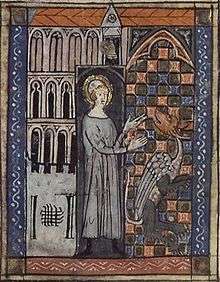Amandus
| Saint Amand | |
|---|---|
 Saint Amandus and the serpent, from a 14th-century manuscript | |
| Born |
584 Lower Poitou, Neustria, France |
| Died |
675 Saint-Amand |
| Venerated in |
Roman Catholic Church Eastern Orthodox Church |
| Feast | February 6 (formerly February 1 and October 26)[1] |
| Attributes | Chair, church, flag |
| Patronage | Wine makers, Beer brewers, merchants, innkeepers, bartenders |
Amandus (c. 584 – 675 AD), commonly called Saint Amand, was a bishop of Tongeren-Maastricht and one of the great Christian missionaries of Flanders. He is venerated as a saint, particularly in France and Belgium.
Life
The chief source of details of his life is the Vita Sancti Amandi, an eighth-century text attributed to Beaudemond (Latin: Baudemundus). The vita was expanded by Philippe, abbot of Aumône. According to this biography, Amand was born in Lower Poitou. He was of noble birth but at the age of twenty, he became a monk on the Île d'Yeu, against the wishes of his family. From there he went to Bourges and became a pupil of bishop Austregisilus. There he lived in solitude in a cell for fifteen years, living on no more than bread and water.[2]
After a pilgrimage to Rome, he was made a missionary bishop in France in 628, without a fixed diocese. At the request of Clotaire II, he evangelized the pagan inhabitants of Ghent, later extending his field of operations to all of Flanders. Initially, he had little success, suffering persecution and undergoing great hardships. However, after allegedly performing a miracle (bringing back to life a hanged criminal) the attitude of the people changed and he made many converts.[2] He founded a monastery at Elnon where he served as abbot for four years. Amandus was made a bishop in 628.[3]
Returning to France in 630, he angered Dagobert I by attempting to have the king amend his life. In spite of the intervention of Saint Acarius, Amand was expelled from the kingdom. Later Dagobert asked him to return and tutor the heir to the throne. Amand however declined. In 633, Amandus founded two monasteries in Ghent; one at Blandinberg, and the other named for St. Bavo, who gave his estate for its foundation.[4] His next missionary task was among the Slavic people of the Danube valley in present-day Slovakia but this was unsuccessful. Amand went to Rome and reported to the Pope.[2] While returning to France, he is said to have calmed a storm at sea. In 639, he built an abbey near Tournay.
From 647 till 650, Amand briefly served as Bishop of Maastricht. The pope gave him some advice on how to deal with disobedient clerics and warned him about the Monothelite heresy, at that time prevalent in the East. Amand was commissioned by the pope to organize church councils in Neustria and Austrasia in order to pass on the various decrees from Rome. The bishops asked Amand to transmit the proceedings of the church councils to the pope. He resigned the see to St. Remaclus, to resume his missionary work.[4]
Around this time, Amand established contact with the family of Pepin of Landen and helped Gertrude of Nivelles and her mother Itta establishing the famous monastery of Nivelles. At the same time, he was now 70 years old, the inhabitants of the Basque country asked him to return to their country to evangelize, although 30 years earlier he had preached there in vain. Returning home, he founded several more monasteries in present-day Belgium with the help of king Dagobert.
Amand died in Elnone Abbey (later Saint-Amand Abbey, in Saint-Amand-les-Eaux, near Tournai) at the age of ninety.[4] His feast day is 6 February. Although mostly revered in Flanders and Picardy, he is also venerated in England, where at least one private chapel (at East Hendred in Oxfordshire) is dedicated to him.
Veneration
Saint Amand is the patron saint of all who produce beer: brewers, innkeepers and bartenders. He is also the patron of vine growers, vintners and merchants, and of Boy Scouts.
Notes
- ↑ Calendar of Saints in the Diocese of Liège (15th c.).
- 1 2 3 Campbell, Thomas (1907). "St. Amandus", The Catholic Encyclopedia. Vol. 1. New York: Robert Appleton Company.
- ↑ "Saint Amandus", Treasures of Heaven, Columbia University
- 1 2 3 Butler, Alban. "St. Amandus, Bishop and Confessor", The Lives of the Saints, Vol. III, 1866
References
- Acta Sanctorum (Antwerp, 64 vols, 1643-), Feb 1 (1658), 815-904
- Krusch, B, Monumenta Germaniae Historica, Scriptores rerum merov., V, 395-485
- Moreau, E de, Saint Amand (1927) An abbreviated version is Moreau, Saint Amand, le principal évangélisatur de la Belgique, 1942.
- Moreau, E de, La Vita Amandi Prima et les Fondations monastiques de St Amand, Analecta Bollandiana lxvii (1949), 447-64
External links
| Wikimedia Commons has media related to Saint Amand. |
![]()